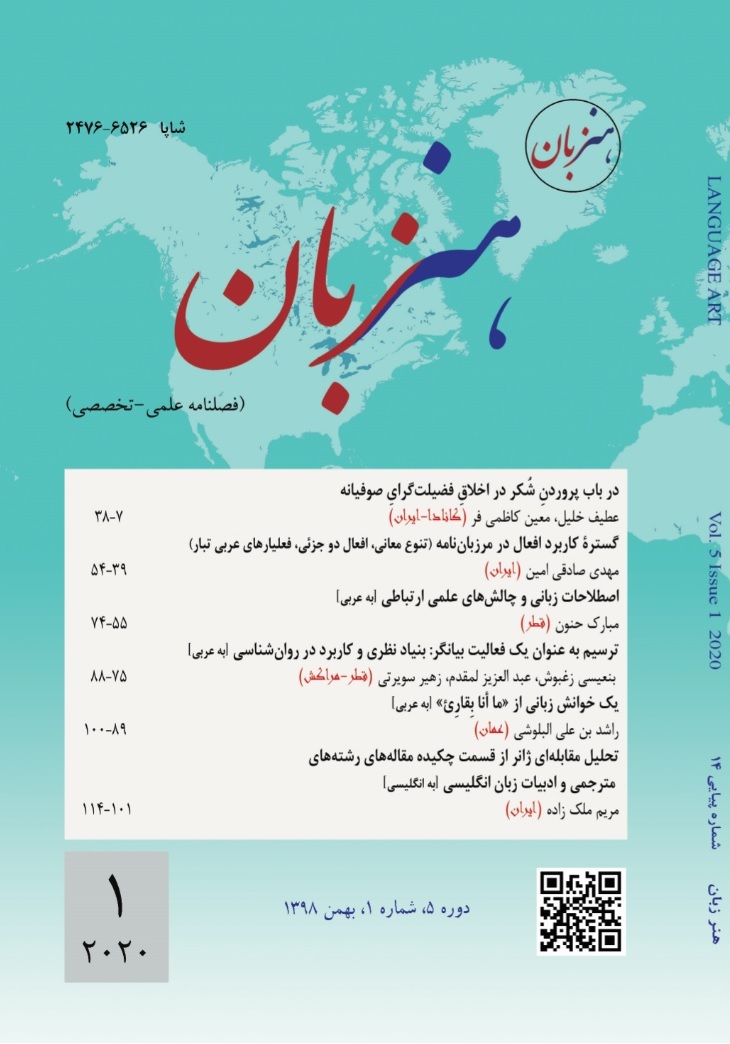تحلیل مقابلهای ژانر از قسمت چکیده مقالههای رشتههای مترجمی و زبان و ادبیات انگلیسی
DOI::
https://doi.org/10.22046/LA.2020.06کلمات کلیدی:
چکیده، ژانر، تجزیه و تحلیل ژانر، حرکت، گام.چکیده
چکیده مقالات زمینهای مهم برای مشاهده جهد و کوشش علمیاند. نوشتن چکیدهای واضح و حاوی اطلاعات مفید برای هر جامعه مباحثه تحصیلی یک ضرورت است. چکیدهها معمولا اطلاعاتی در مورد پیشینه حوزه و روش تحقیق و یافتههای اصلی و نتایج فراهم میآورند.پیشینه پژوهش در حیطه تحلیل ژانری مقابلهای نشان میدهد که تفاوتهای معانی بیانی احتمالی بین قسمت چکیده مقالات رشتههای مترجمی و ادبیات زبان انگلیسی تاکنون مورد بررسی و تحلیل قرار نگرفته است. بنابراین مقایسه ساختار معانی بیانی چکیده مقالات نوشته شده دراین رشتهها و پاسخ به سوالات طرح شده به عنوان هدف اصلی این تحقیق مورد توجه است. اینکه چه ساختارهایی قسمت چکیده این مقالات را شکل میدهد و چه تفاوتهای اصولی بین آنها وجود دارد. صد چکیده از مقالات تحقیقی رشتههای مترجمی و ادبیات انگلیسی منتشر شده در مجلات بینالمللی برای بررسی و تحلیل ساختار معانی بیانی تجزیه و با پیروی از مدل کار سولز تحلیل شدند. این تجزیه و تحلیل بین رشتهای نشان داد که تفاوتهای بارزی بین ساختارهای معانی بیانی پنجاه چکیده ازمقاله مترجمی و پنجاه چکیده از مقالات ادبیات انگلیسی وجود ندارد جز در نشان دادن گپ آشکار شد که چکیدههای مقالات مترجمی و ادبیات انگلیسی اغلب اشاره واضحی به هدف اصلی تحقیق، نتایج اساسی و اصول و روش تحقیق دارند. چکیدههایی که شامل کمتر از سه گام هستند اغلب مبهم محسوب میشوند خصوصا برای خوانندهای که خارج از جامعهی مباحثهای تحصیلی در زمینه خاص تحقیق است. یک نتیجه از این تحقیق میتواند حساس کردن محققان متخصص نسبت به ارزش نوشتن چکیدههای واضح باشد.مراجع
Ahmad, V.K. (1997). Research article introductionsin Malay: rhetoric in an emerging research community, In A. Duszak (Ed), Culture and Styles of academic discourse, p. 273-303.
ANSI (1979). The American standard for writing abstracts. New York: ANSI Publication
Bhatia, V. K. (2004). Worlds of written discourse. London, Continuum.
Bhatia, V. (1993). Analyzing genre: Language Use in Professional Settings, London Longman.
Brett, P. (1994). A genre analysis of the results section of sociology articles, English for Specific Purposes, 13, 47-59.
Cross, C., Oppenheim, C. (2006). A genre analysis of scientific abstracts, Journal of Documentation, 62(4), p. 428-446.
Doro, Katalin (2013). The Rhetoric Structure of Research Article Abstracts in English Studies Journals, Journal of English Studies, 2(1), p. 119-139.
Fakhri, A. (2004). Rhetorical properties of Arabic research article introductions, Journal of Pragmatics, 36, p. 1119-1138
Hasrati, M., Gheitury, A. (2010). A Genre Analysis of Persian Article Abstracts: Communicative Moves and Author Identity, Iranian Journal of Applied Language Studies, 2(2), p. 47-74.
Hartley, J. (2003). “Improving the Clarity of Journal Abstracts in Psychology: e Case for Structure”, Science Communication, 24(3), p. 366-379.
Hartley, J., Benjamin, M. (1998). An evaluation of structured abstracts in journal published by the British psychological society, British Journal of Educational Psychology, 68, p. 443-456.
Holmes, R. (1997). Genre analysis and the social sciences: an investigation of the structure of research article discussion section in three Disciplines, English for Specific Purposes, 16.
Hyland, K. (2004). Graduates’ gratitude: The generic structure of dissertation acknowledgements, English for Specific Purposes, 22(3), p. 303–324.
Hyland, Ken. (2000). Disciplinary Discourses: Social Interaction in Academic Writing, London: Longman 2000.
Hyland, K. (1997). Scientific claims and community values: Articulating an academic culture, Language and Communication, 17 (1), p. 19-31.
Jalilifar, A. R. (2010). Research article introductions: Sub-disciplinary variations in Applied linguistics, The Journal of Teaching Language Skills (JTLS), 2.2, p. 29-55.
Marefat, H., Mohammadzadeh, Sh. (2013). Genre analysis of Literature research article abstracts: A Cross-Linguistic, Cross-Cultural Study, Applied Research on English Language, 2(2), p. 37-50.
Martin, P. M. (2003). A genre analysis of English and Spanish research paper abstracts in experimental social sciences, English for Specific Purposes, 22(1), p. 25-43.
Ozturk, I. (2007). The textual organization of research article introductions in applied linguistics: Variability within a single discipline. English for Specific Purposes, Published by Elsevier. Ltd, 26, p. 25-28.
Safnil.(2000). Rhetorical structure analysis of the Indonesian research articles. Unpublished PhD dissertation. The Australian National University, Canberra, Australia.
Salager-Meyer, F. (1990). Discourse flaws in medical English abstracts: a genre analysis per research and text type, 10, p. 365-384
Samraj, B. (2008). A discourse analysis of masters’ theses across disciplines with a focus on introductions, Journal of English for Academic Purposes, 7(1), p. 55- 67.
Samraj, Betty (2005). “An Exploration of a Genre Set: Research Article Abstracts and Introduction in Two Disciplines.” English for Specific Purposes, 24,p.141-56.
Samraj, B. (2002). ‘Introductions in Research Articles: Variation across Disciplines’, English for Specific Purposes, 21, 1-17.
Santos, M.B. (1996). “The Textual Organization of Research Paper Abstracts in Applied Linguistics.” , 16(4), p. 481-99.
Swales, J. M. (2004). Research genres: Exploration and applications. Cambridge University Press.
Swales, J. M. (1990). Genre Analysis. English in Academic and Research Settings. Cambridge: Cambridge University Press.
Williams, I. (1999). Results sections of medical research articles: Analysis of rhetorical categories for pedagogical purposes, English For Specific Purposes, 18(4), p. 347-366.
Yang, R, Allison, D. (2003). Research articles in applied linguistics: Moving from results to conclusions, English for Specific Purposes, 22, p. 365-385.
##submission.downloads##
چاپ شده
ارجاع به مقاله
شماره
نوع مقاله
مجوز
حق نشر 2020 مریم ملک زاده

این پروژه تحت مجوز بین المللی Creative Commons Attribution 4.0 می باشد.
فصلنامه هنر زبان یک مجله دسترسی آزاد است و مقالات پس از پذیرش در دسترس عموم قرار می گیرند و استفاده از آن با ذکر منبع آزاد است
